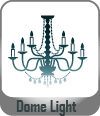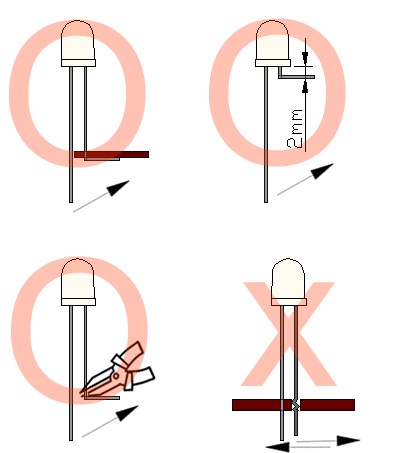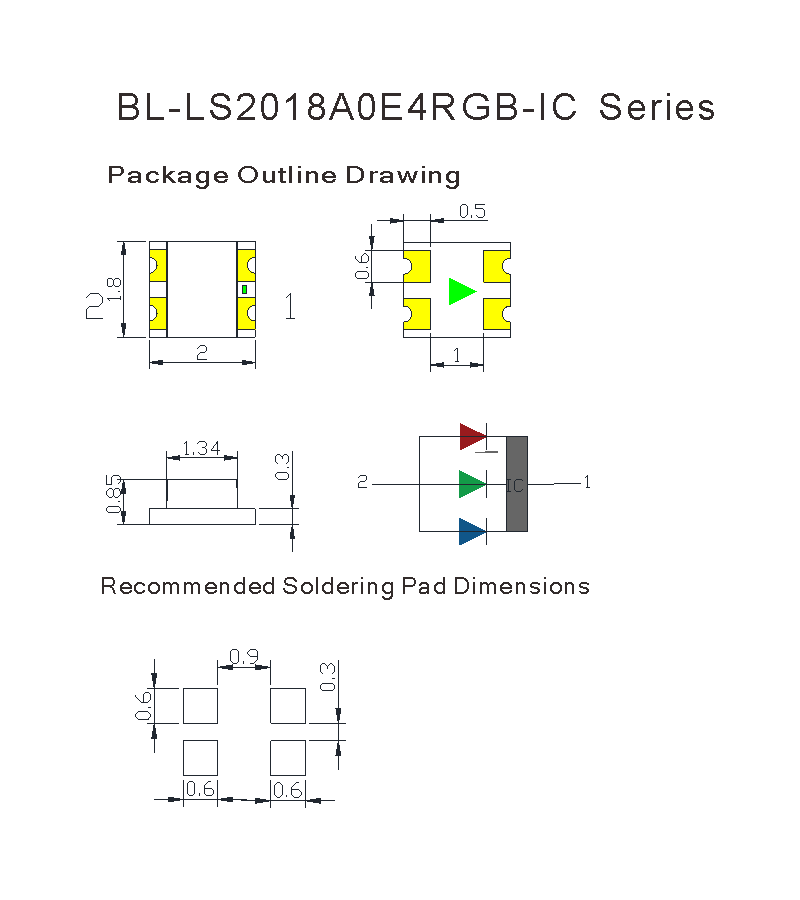2018 SMD LED, RGB-color, IC
Series No:
Weight:(g/pcs)
Dimension:(mm)
Package:
Specification:
Inquiry
Description:
Understanding 2018 SMD LED, RGB-Color, and IC
The 2018 SMD LED model is not just a typical LED; it incorporates an integrated circuit (IC) and offers RGB-color capabilities, making it a powerhouse for color control and output customization. The inclusion of an IC within the LED package allows for smarter control and more stable performance, crucial for sophisticated lighting systems. This tri-color LED technology can emit red, green, and blue light, which can be mixed to create a wide spectrum of colors, enhancing its utility in dynamic lighting applications.
Features of 2018 SMD LED, RGB-Color, IC
- Compact Design: Integrates multiple components into one small package, saving space and reducing the complexity of circuit designs.
- Advanced Color Mixing: Offers precise control over color blending, providing endless possibilities for customization and ambiance enhancement.
- Enhanced Efficiency: The IC integration helps in managing power consumption more effectively, ensuring that the LED operates optimally for longer durations.
Applications of 2018 SMD LED, RGB-Color, IC
This LED technology is versatile, finding applications in:
- Consumer Electronics: Used in TVs, smartphones, and other devices for display backlighting and status indicators.
- Smart Home Devices: Integral in smart lighting systems that adjust color temperatures and settings based on user preferences or external conditions.
- Automotive Lighting: Utilized in vehicle cabin lighting and dashboard displays, offering customizable color options and improved aesthetic appeal.
Benefits of Using 2018 SMD LED, RGB-Color, IC
Employing this advanced LED technology offers multiple advantages:
- Superior Performance: Delivers vibrant, consistent light quality that enhances the user experience in any application.
- Energy Savings: The efficient use of power not only reduces costs but also contributes to environmental sustainability.
- Innovative Design Flexibility: Allows designers to explore creative, compact, and complex lighting setups without compromising on performance.
Case Studies: Demonstrating the Impact of 2018 SMD LED
- Smartphone Backlighting: A leading smartphone manufacturer implemented the 2018 SMD LED in their latest model, achieving superior display brightness and color accuracy, enhancing the overall user experience.
- Automotive Interior Lighting: A premium car brand used these LEDs to offer customizable interior lighting options, significantly boosting the vehicle’s luxury appeal and functionality.
User Testimonials
- Elena Miro, Product Developer at LuxGadgets: “Integrating the 2018 SMD LED, RGB-color, IC into our product line transformed the way we approached lighting solutions, offering our customers unparalleled customization.”
- Tom Richards, Senior Purchaser at AutoTech Inc.: “The reliability and versatility of these LEDs have made them a top choice for our automotive lighting solutions, impacting both the design and functionality of our products.”
Conclusion: Embrace the Future with 2018 SMD LED, RGB-Color, IC
The 2018 SMD LED with RGB-color capabilities and an integrated IC is redefining the landscape of electronic lighting. Its ability to deliver vibrant, customizable lighting while maintaining efficiency and performance makes it an essential component for any forward-thinking electronics project.
Call to Action: Upgrade your projects with the innovative 2018 SMD LED. Contact us today to learn how these LEDs can illuminate your next big idea!

Features: 2018 SMD LED, RGB-color, IC
- Compact size: 2.0mm x 1.8mm SMD
- RGB-color type with ultra brightness
- Compatible with automatic placement equipment
- Wide viewing angle for versatile visibility
- Ideal for backlighting and indicator applications
- Package includes 4000 pieces per reel
- RoHS Compliance
Application:
- Backlighting for electronic displays and screens
- Indicator lights in various electronic devices
- Decorative lighting with RGB-color capability
- General-purpose illumination in confined spaces
- Integration into compact electronic designs
- Visual signaling in consumer electronics
- Compact lighting solutions in different applications


Electrical-optical characteristics:
Package configuration & Internal circuit diagram
Partno description:
More Information
Lens Color:
| Code | D | T | C | W | E | |
| Meaning | color Diffused | Color Tinted | Water Clear | Water Diffused | Orange diffused |
Absolute maximum ratings (Ta=25°C)
| Parameter | SR | LR | UR | UE | UY | UG | PG | BG | B | UB | UV | W | Unit |
| Forward Current I F | 25 | 25 | 25 | 30 | 30 | 30 | 30 | 30 | 30 | 30 | 30 | 30 | mA |
| Power Dissipation P d | 60 | 60 | 60 | 65 | 65 | 75 | 110 | 110 | 120 | 120 | 120 | 120 | mW |
| Reverse Voltage V R | 5 | 5 | 5 | 5 | 5 | 5 | 5 | 5 | 5 | 5 | 5 | 5 | V |
| Peak Forward Current I PF (Duty 1/10 @1KHZ) | 150 | 150 | 150 | 150 | 150 | 150 | 150 | 100 | 100 | 100 | 100 | 100 | mA |
| Operation Temperature T OPR | -40 to +80 | °C | |||||||||||
| Storage Temperature T STG | -40 to +85 | °C | |||||||||||
| Lead Soldering Temperature T SOL | Max.260+-5°C for 3 sec Max. (1.6mm from the base of the epoxy bulb) | °C | |||||||||||
Related Information
Applied for:




The LEDs described here are intended to be used for ordinary electronic equipment (such as office equipment,
communication equipment and household applications). Consult Betlux’s Sales in advance for information on
applications in which exceptional reliability is required, particularly when the failure or malfunction of the LEDs
may directly jeopardize life or health (such as in aviation, transportation, traffic control equipment, medical
and life support systems and safety devices).
CAUTIONS for Through-Hole LED Lamps
1. Application
The LEDs described here are intended to be used for ordinary electronic equipment (such as office equipment, communication equipment and household applications). Consult Betlux’s Sales in advance for information on applications in which exceptional reliability is required, particularly when the failure or malfunction of the LEDs may directly jeopardize life or health (such as in aviation, transportation, traffic control equipment, medical and life support systems and safety devices).
2. Storage
The storage ambient for the LEDs should not exceed 30℃ temperature or 70% relative humidity. It is
recommended that LEDs out of their original packaging are used within three months
For extended storage out of their original packaging, it is recommended that the LEDs be stored in a sealed
container with appropriate desiccant or in a desiccator with nitrogen ambient.
3. Cleaning
Use alcohol-based cleaning solvents such as isopropyl alcohol to clean the LED if necessary
4. Lead Forming & Assembly
During lead forming, the leads should be bent at a point at least 3mm from the base of LED lens. Do not use
the base of the leadframe as a fulcrum during forming.
Lead forming must be done before soldering, at normal temperature.
During assembly on PCB, use minimum clinch force possible to avoid excessive mechanical stress.


Soldering
When soldering, leave a minimum of 2mm clearance from the base of the base of the lens to the soldering point. Dipping the lens into the solder must be avoided.
Do not apply any external stress to the lead frame during soldering while the LED is at high temperature.
Recommended soldering conditions:
| IR Reflow Soldering (for SMD display) | Wave Soldering | Soldering Iron | |||
| Pre-Heat | 150-180°C | Pre-Heat | 100°C Max. | Temperature | 300°C Max. |
| Pre-Heat Time | 120sec Max. | Pre-Heat Time | 60sec Max. | ||
| Peak Temperature | 260°C Max. | SolderWave | 260°C Max. | Soldering Time | 3sec Max.(one time only) |
| Soldering Time | 10 sec Max. | Soldering Time | 5sec Max. | ||
Note: Excessive soldering temperature and/or time might result in deformation of the LED lens or failure of the LED
ESD(Electrostatic Discharge)
Static Electricity or power surge will damage the LED.
Suggestions to prevent ESD (Electrostatic Discharge):
n Use a conductive wrist band or anti-electrostatic glove when handling these LEDs
n All devices, equipment, and machinery must be properly grounded
n Work tables, storage racks, etc. should be properly grounded
n Use ion blower to neutralize the static charge which might have built up on surface of the LED’s
plastic lens as a result of friction between LEDs during storage and handling
ESD-damaged LEDs will exhibit abnormal characteristics such as high reverse leakage current,
low forward voltage, or “no light on” at low currents. To verify for ESD damage, check for “light on”
and Vf of the suspect LEDs at low currents.
The Vf of “good” LEDs should be>2.0V@0.1mA for InGaN product and >1.4V@0.1mA for AlInGaP
product.

Drive Method
An LED is a current-operated device. In order to ensure intensity uniformity on multiple LEDs connected in
parallel in an application, it is recommended that a current limiting resistor be incorporated in the drive circuit,
in series with each LED as shown in Circuit A below.

When selecting power for LED systems, it’s essential to understand several key parameters to ensure safe operation, longevity, and optimal performance. Here are some steps and considerations for LED power selection:
- Determine the Forward Voltage (Vf) of the LED(s):
Each LED has a forward voltage, which is the voltage at which the LED operates when the current is flowing through it. This value can typically be found in the LED’s datasheet.
- Determine the Forward Current (If) of the LED(s):
The forward current is the current at which the LED is designed to operate. Running an LED at higher than its rated current can reduce its lifespan and increase the heat it produces.
- Decide on the Configuration:
Series Configuration: When LEDs are connected in series, the forward voltages add up, but the current remains the same.
Parallel Configuration: When LEDs are connected in parallel, the forward voltage remains the same, but the currents add up. This configuration can be risky because if one LED fails or has a slightly lower forward voltage, it can cause the other LEDs to draw more current.
Calculate Total Power Requirements:
Power (W) = Total Forward Voltage (V) x Total Forward Current (A)
For example, if you have three LEDs connected in series, each with a forward voltage of 3V and a forward current of 20mA, the total power requirement would be:
Power = (3V + 3V + 3V) x 20mA = 9V x 0.02A = 0.18W
- Select an Appropriate Power Supply:
- Voltage Rating: The power supply voltage should match or slightly exceed the total forward voltage of your LED configuration.
- Current Rating: The power supply’s current rating should meet or exceed the total forward current of your LED configuration.
- Safety Margin: It’s a good practice to select a power supply that can provide at least 20% more power than your calculated requirement. This ensures the power supply isn’t operating at its maximum capacity, which can extend its life and ensure safer operation.
- Consider Additional Features:
- Dimming Capability: If you want to control the brightness of your LEDs, choose a power supply with dimming capabilities.
- Overcurrent and Overvoltage Protection: To protect your LEDs, select a power supply with built-in protection mechanisms.
- Thermal Management: Ensure that the power supply has adequate cooling, especially if it will be enclosed or in a location with limited airflow.
- Regulation and Efficiency:A power supply with good regulation will maintain a consistent voltage output despite variations in the load. High efficiency ensures minimal power is wasted as heat.
- Physical Size and Form Factor:Depending on where you plan to place the power supply, its size and shape may be critical factors.
In summary, when selecting power for LED systems, understanding your LED’s requirements and the configuration you plan to use is essential. Then, pick a power supply that meets those needs with some added safety margin, keeping in mind any additional features or constraints relevant to your project.
Here are some well-regarded brands in the industry:
- Mean Well: One of the most recognized brands in the LED power supply industry, Mean Well offers a wide range of products suitable for both indoor and outdoor applications. Their units often come with features like overcurrent protection, dimming capabilities, and high efficiency.
- Tridonic: A global leader in lighting technology, Tridonic offers LED drivers and power supplies that cater to various lighting solutions, from simple setups to advanced smart lighting systems.
- Philips Advance Xitanium: Philips is a well-known brand in the lighting industry, and their Xitanium series of LED drivers are known for reliability and performance. They cater to both indoor and outdoor LED applications.
- Osram: Another giant in the lighting industry, Osram offers a range of LED drivers and power supplies suitable for various applications, including architectural and street lighting.
- LIFUD: Specializing in LED drivers, LIFUD is known for its high-quality products that cater to both commercial and residential LED lighting solutions.
- MOSO: This brand offers a variety of LED drivers, especially for outdoor and industrial applications. Their products are known for durability and performance.
- TDK-Lambda: With a history in power electronics, TDK-Lambda offers a range of power supplies and LED drivers suitable for various applications, emphasizing reliability and advanced features.
Need help?
Related products
-

0,48-дюймовый трехразрядный семисегментный светодиодный дисплей
Quick View View products -

Трехразрядный светодиодный индикатор с диагональю 0,4 дюйма
Quick View View products -

0,56-дюймовый трехразрядный семисегментный светодиодный дисплей
Quick View View products -

0,39-дюймовый трехразрядный семисегментный светодиодный дисплей
Quick View View products



